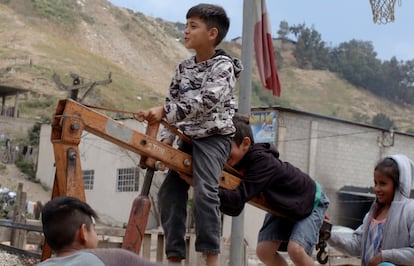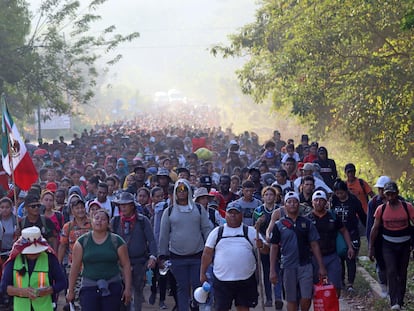‘Far from home’: The migration crisis in Tijuana through the eyes of children
Carlos Hernández’s documentary portrays some of the reasons that have led 19,000 children and adolescents a year to seek a better life in the United States


“First they wanted me to sell me for parts, my organs, or else to prostitute me. I refused to do that, so they told me to work deceiving girls so they could do to them everything they wanted to do to me. I accepted because they tied my father to a chair and threatened him with a gun,” says one witness. “Two of my cousins had already disappeared and they were stealing children from the schools,” says another person in front of the camera. “The last time, the heaviest shooting in my town lasted almost three and a half hours,” recalls another.
What these experiences have in common is violence. Some took place in Mexico, others in Honduras, El Salvador, or Haiti. These are the stories of survivors who speak out in one of the many shelters in the state of Tijuana, 35 kilometers (22 miles) from the U.S. border. Those who tell their stories — Lázaro, Patricia, Marvin, Ximena, Chuy, Betsy, to mention a few — also have something else in common: they are all children or teenagers, seeking a better life far from their homes and who give a voice and a face to the migratory crisis between the two countries.
Lejos de casa (Far from home), the second documentary by Carlos Hernández, follows a group of children and adolescents, originally from various Latin American countries, who live in shelters in Tijuana. All of them are waiting for a response to their asylum request to enter the United States. The wait is long and uncertain; these are childhoods on pause. The director spent three years with cinematographer Luis Montalvo working on migration issues on the Mexican side of the border. When a migrant caravan arrived, they noticed “a change in the migration paradigm.”
“It was evident that we were no longer in the presence of only, or mostly, men who were looking for better working conditions, but of entire families and even minors traveling alone. So, faced with such a radical change from what we had witnessed during our stays in Tijuana, we decided to turn the camera toward the children,” says the director.
The filming of the documentary took three months, the period of time that most of the minors would spend in the shelters waiting for their U.S. asylum application to be processed. Hernández found the voices of the protagonists for his film through a natural process. “What I always say is that we chose each other during the work process. Before we started filming, we were living with the boys and girls, talking, eating, playing with cars, or soccer. This generated interaction and began to build bonds of trust and a certain friendship, which I think was a reciprocal element that, in the end, when we started to take the camera out, led them to decide whether to participate,” he says.
Hernández says that, through the testimonies, his challenge was to raise awareness of the problems the region is experiencing: despite the magnitude of the situation, the director affirms that there is still a lack of knowledge and the fact that child migration occurs in such large numbers is ignored. According to the documentary, 19,000 minors apply for asylum in the United States every year.
“These are very tough stories regarding their relationship with their places of origin, as a result of the presence of drug-trafficking, gangs, or the political persecution they face. It is something systemic throughout the region. That is what we should be talking about to really understand, or begin to understand, the seriousness of the situation. We should be talking about displaced people and a humanitarian crisis as a result of constant violence,” Hernández adds.
A key factor in the filming was trust, a feeling that was reinforced, admits Hernández, when the children and adolescents who lent their voices to the documentary realized that they were not producing soft content and that the film crew was not trying to open wounds, but, on the contrary, the intention of “responsible work” was involved.
“It’s hard for us to look at girls and boys, at least at those ages, at their childhoods, and listen. I think that’s one of the things the film contributes, what they are going through, their emotions, their thoughts. It should be noted that these are hard stories, but all of them are tinged by the children’s own playful processes. Observing them makes you realize the resilience they have, which makes them transform things into games, and that helps to understand much more transparently the situation they are going through,” says Hernández.
Lejos de casa is on general release in Mexico but has above all been screened at festivals for minors, girls and boys, and the empathy that this generates in young people is “very impressive,” says Hernández, because they identify very naturally with concepts such as home, friendships, goodbyes, and relationships.
“The [American government’s] Remain in Mexico policy has been devastating for many families and the persecution that they now also experience in our country is so evident that I think the documentary was born out of a very real need to try to portray what is happening in such a way that we can generate empathy, first among Mexican citizens themselves, and then with the authorities so that humanitarian public policies are generated and real help is given to all these people who are displaced,” Hernández concludes.
Sign up for our weekly newsletter to get more English-language news coverage from EL PAÍS USA Edition
Tu suscripción se está usando en otro dispositivo
¿Quieres añadir otro usuario a tu suscripción?
Si continúas leyendo en este dispositivo, no se podrá leer en el otro.
FlechaTu suscripción se está usando en otro dispositivo y solo puedes acceder a EL PAÍS desde un dispositivo a la vez.
Si quieres compartir tu cuenta, cambia tu suscripción a la modalidad Premium, así podrás añadir otro usuario. Cada uno accederá con su propia cuenta de email, lo que os permitirá personalizar vuestra experiencia en EL PAÍS.
¿Tienes una suscripción de empresa? Accede aquí para contratar más cuentas.
En el caso de no saber quién está usando tu cuenta, te recomendamos cambiar tu contraseña aquí.
Si decides continuar compartiendo tu cuenta, este mensaje se mostrará en tu dispositivo y en el de la otra persona que está usando tu cuenta de forma indefinida, afectando a tu experiencia de lectura. Puedes consultar aquí los términos y condiciones de la suscripción digital.
More information
Archived In
Últimas noticias
Most viewed
- Sinaloa Cartel war is taking its toll on Los Chapitos
- Oona Chaplin: ‘I told James Cameron that I was living in a treehouse and starting a permaculture project with a friend’
- Reinhard Genzel, Nobel laureate in physics: ‘One-minute videos will never give you the truth’
- Why the price of coffee has skyrocketed: from Brazilian plantations to specialty coffee houses
- Silver prices are going crazy: This is what’s fueling the rally










































